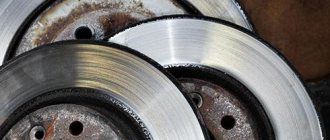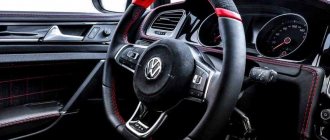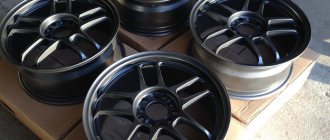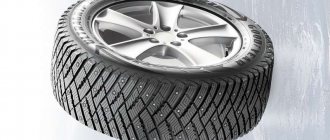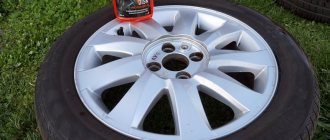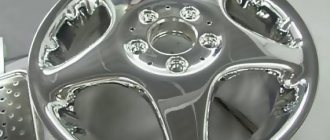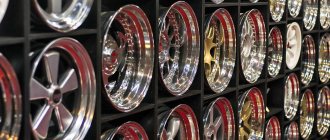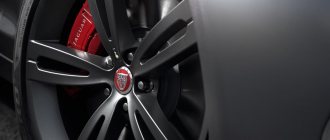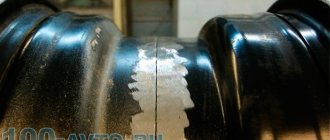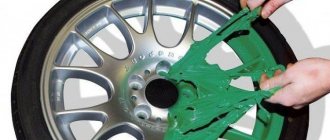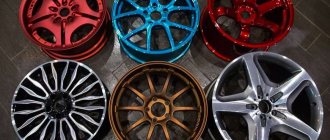The braking system of modern cars consists of a rotating disc and stationary brake pads, which apply pressure to the disc from both sides to slow down the movement. The geometry of the moving element of the brakes must be almost ideal. Otherwise, braking efficiency is significantly reduced.
The curvature of the surface of the brake elements poses a danger to the life and health of motorists, so their condition must be regularly monitored. If functionality is impaired, it must be replaced.
But often service stations that have the appropriate equipment advise a cheaper way out of the situation - regrooving the brake discs. The benefits of workshops are clear, but is it worth the trouble for the driver?
Why do they grind discs?
When the discs are deformed, the braking distance increases to 20 meters, so the condition of these elements requires constant attention. It is especially important to do this on modern cars with ABS and PBS systems, since here the safety of the driver and passengers depends on the coordinated actions of all elements of the braking system. This will be entirely determined by the driving skill of the person driving the car on a slippery road.
If the surface of the discs is rough and uneven, then even replacing the brake pads will not give the desired result until they are ground in.
If vibrations occur in the vehicle or the brake pedal, the brake system must be checked immediately.
In case of disc geometry violation, many service stations recommend regrooving. Most manufacturers recommend replacing these elements of the brake system only after 80 thousand kilometers, so repairing these parts can be considered justified.
The moving parts of the brakes are expensive. On the other hand, they have an increased service life compared to static pads. Recently, some car workshops have begun to purchase equipment for turning brake discs. This procedure is much cheaper than a new purchase, so the service is in demand.
Other disc defects requiring resurfacing
During operation, disks are exposed to shock loads, aggressive environments, as well as various other external and internal factors. As a result, they have a number of defects, which can be eliminated by resorting to grooving:
- Deformation of the disk under the influence of temperature differences. When braking, the disk heats up, and during sudden cooling, for example, when the wheel gets into a puddle of water, it “drives” under the influence of temperature stresses.
- Local disk overheating. When braking sharply at high speed, the temperature can reach very high values, which will lead to disruption of the metal structure. Blue spots appear on the working surface of the disk.
- Corrosion damage to the working surface of the disk. Corrosion is caused by salts, reagents and other components of an aggressive environment.
- Dents on the working surface due to improper cleaning of the disk from dirt.
Signs that indicate discs need sharpening
The following signs indicate that the time has come to give the discs for sharpening:
- Increased vehicle vibration.
- Beating of the brake pedal and steering wheel when braking ().
- Increased noise when braking.
- Increased braking distance.
- Braking becomes less effective.
Risks and acceptable values
Before agreeing to the specialists’ offer, it is important to make sure that such a procedure makes sense at all, since sometimes only replacing them will help:
- If there are cracks or chips in the base, then it is better to throw such elements into a landfill. Otherwise, the brakes may simply fall apart while driving, causing an accident.
- You need to be very careful when making repairs when the disc thickness is minimal, since thin metal will heat up faster.
- After grooving, it is recommended to operate the machine exclusively in a gentle mode.
Despite the limitations described above, workshops with lathes advise turning brake discs for almost any reason.
Before grooving, it is important to determine the thickness of these elements after working with them.
Valid values:
- for products with ventilation they are 0.5-0.6 cm;
- for varieties without ventilation - 0.8-0.9 cm.
Only after preliminary calculations does work on the lathe begin. Such a unit independently rotates the hub, cutting off a thin layer of metal using cutters that move from the center to the periphery. Most often, the part is processed in two or three such passes.
Before starting grooving, the technician must carefully examine not only the condition of the disk itself, but also the wheel bearing. If the latter has a backlash, then there is no point in making a groove. After the procedure, the runout value, the level of corrosion, and the residual thickness of the workpiece are checked. In addition, the old brake pads need to be replaced.
Most often, discs are made of cast iron. This metal changes properties under the influence of sudden temperature changes. Because of this, the working surface warps and its internal structure is damaged.
As a result of processing on the machine, only the top layer is removed, but after several hard braking this element can “lead” again. A damaged disk during processing can only be identified by a very highly qualified specialist.
Brake disc thickness, permissible brake disc thickness
The minimum thickness of brake discs depends on the make of the vehicle and its model. Each manufacturer sets specific wear parameters depending on the characteristics of a particular vehicle.
That is, there are no universal evaluation criteria. The wear of the element directly depends on the driver’s driving style, his braking style and the condition of the road surface - if you constantly drive in rocky areas, the brake discs wear out much faster. In addition, the premature wear of brake discs is greatly influenced by the insufficient area between the disc and the pad.
To prevent accidents, car manufacturers indicate the nominal and minimum thickness of the element on the disks themselves in the form of two marks. It is worth saying that manufacturers indicate the minimum thickness with a margin, slightly increasing the figures.
We recommend: What to do if the engine overheats?
In order to check whether the brake discs on your vehicle are fake, pick up the brake disc and look at it carefully. Here you should see two numbers, the first of which will indicate the initial thickness of the element, and the second - the minimum acceptable value. If you do not see any markings on the brake disc, then it is simply fake, that is, a fake.
What is more profitable: replacing the disc or regrowing it?
In terms of time, replacing discs or carrying out the procedure for turning them is approximately the same. In addition, both when replacing and when regrowing, you will have to dismantle the tire, remove the pads, carry out the necessary repair or replacement procedures, then install the pad back and install the tire in place. It turns out that the repair of brake discs is comparable in many factors to a complete replacement of the pads. Therefore, in the end, only a master can determine the feasibility of a complete change of pads or the possibility of repairing existing ones, especially since in terms of price, these two procedures are also not very different.
In what cases should you not grind brake discs?
TD grinding is not performed in all cases; the disc should not be sharpened if:
- the thickness of the working surface is less than acceptable (for example, for the Lada Kalina it is 17.8 mm);
- the curvature of the disk is too great, the part will be difficult to restore;
- there are obvious defects on the surface - cracks, deep depressions, signs of burnt metal;
- the cost of the parts is low, it is easier and cheaper to install a new TD than to grind;
- The car has special sports wheels that cannot be restored.
Some car owners grind discs in another interesting way - they insert wedges from a grinder cutting wheel into the brake pads, having previously cut out a piece of the lining, and operate the car for some time with such linings. In this case, the surface of the TD is polished on the move at the moment the brakes are applied. The ingenuity of car enthusiasts can be envied, but this method is very risky - the brake disc can become very hot from overheating and burst while driving. It is clear that the consequences can be unpredictable, so it is better not to risk it.
Turning discs in car services using Pro Cut equipment is completed on average within two hours; you will have to pay approximately 2,000 rubles for the work. The cost of a Chevrolet Niva brake disc is approximately 800 rubles, VAZ 2108-2114 is about 600 rubles. It is also not advisable to grind the TD here; it is easier to buy new parts and replace them.
Grooving brake discs on a Pro Cut bench
The effectiveness of the brakes is of great importance; it determines whether the driver will be able to brake in time to avoid an accident. If the pads and discs are worn unevenly during braking, the brake pedal will wobble and vibration will be transmitted to the steering wheel. The higher the speed of the car, the stronger the defect is felt, so with such a malfunction the car should be operated carefully, and it is better not to delay repairs. Modern diagnostic methods make it possible to check not only the surface quality and thickness of the discs, but also the geometry of the movement of the TD in the caliper; the slightest deviations from the norm are detected in the ProSat equipment by a high-precision dial indicator.
A professional American-developed stand allows you to balance the TD with high accuracy; balancing is no worse than in the factory. The grooving machine is used in specialized car repair shops and service stations; it is capable of servicing several cars per work shift. The installation kit includes several adapters that allow you to adapt the cutters on any side of the machine and work with various car models.
In order to be able to work with the disc, it is necessary to release the caliper bracket; the stand itself is quite light and compact, and is equipped with wheels for ease of movement. Using a retractable rod and a rotating mechanism, adjustments are made in the height and position of the cutting unit, the machine is convenient and easy to use, you can attach the adapter to the wheel hub in just a few minutes.
The adapter is then connected to all other equipment, alignment is done with one bolt and also takes very little time. In order to accurately perform a groove, the cutters should be positioned strictly perpendicular to the hub axis; the desired location of the cutting tool helps to accurately identify the electronic mechanism. To spin the brake disc, the stand is equipped with an electric motor; the gyroscope, available in the Pro Cut circuit, sends a command to the actuator, and the adjustment is done not manually, but automatically.
No additional measuring instruments or devices are required here; professional Pro Cat equipment performs all the work from start to finish. The ideally flat surface obtained after processing on the bench allows you to achieve effective and precise braking, completely eliminating beating when you press the brake pedal.
It is possible to level the working plane even with hubs that are far from ideal, but it should be taken into account that if there are dirt particles or nicks between the disk and the hub, the alignment may be disrupted during subsequent removal and installation of the TD. Therefore, before turning, it is advisable to make sure that the contacting surfaces are even, by dismantling the parts and visually inspecting them.
Restoring brake discs on a lathe
It is also possible to perform TD grooving on a conventional lathe; a standard or specially welded cutter is used for processing. For a professional turner, the work is not difficult; to complete it, you will need:
- clamp the disc in the chuck, remembering to center it well (an indicator is required);
- clean the surface to be treated from rust, check the surface for runout using the same indicator;
- Align the surfaces with the cutter first on one side and then on the other, turning the disk over. Also here you can process the plane where it contacts the hub.
As a rule, turning on a lathe gives good results, vibration disappears during braking. But if nothing has changed and the beating in the steering wheel remains the same, the cause of the defect is probably dirt trapped between the TD and the hub. A lot also depends on the qualifications of the worker; if the center is set inaccurately, nothing good will come of it.
